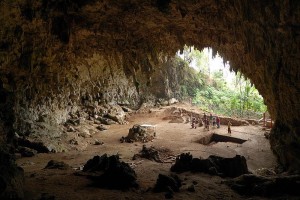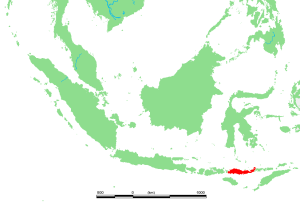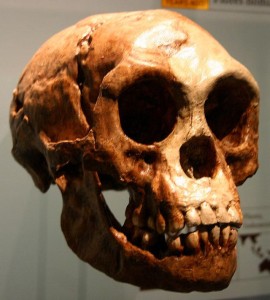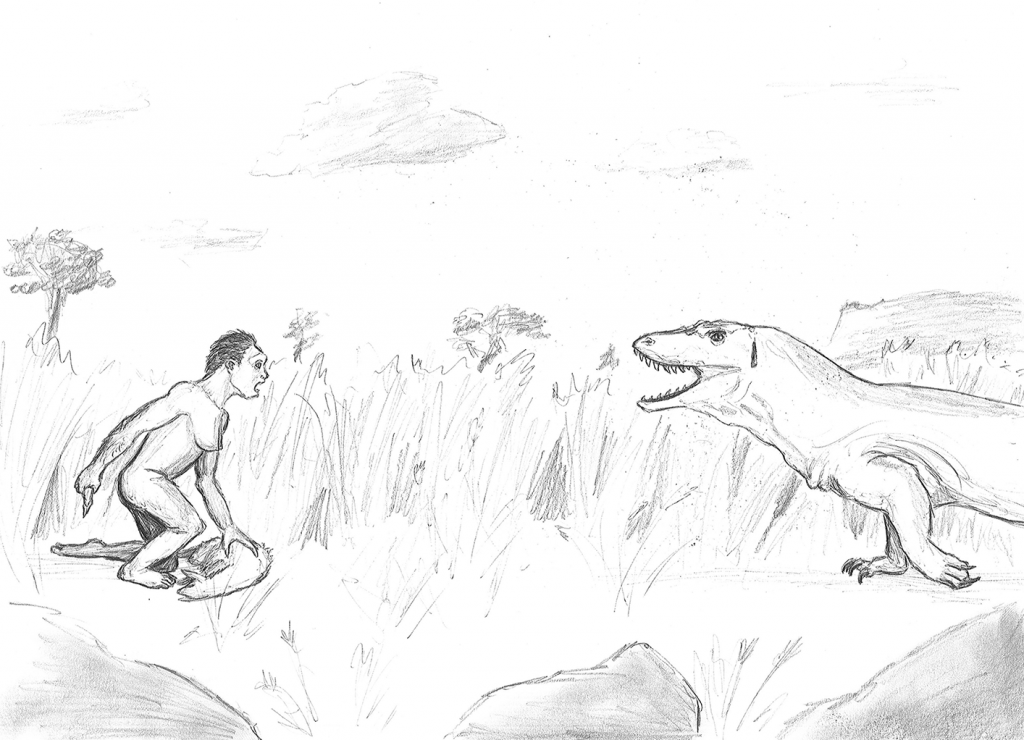32. Homo floresiensis
Homo floresiensis (74–12 kya)
(“same” / Flores)

Momotarou2012
http://commons.wikimedia.org/wiki/File:Homo_floresiensis_Restoration_model.jpg
SITES
Liang Bua cave, Flores, Indonesia
PEOPLE
Mike Morwood

INTRODUCTION
The material assigned to the species Homo floresiensis comes only from the cave site of Liang Bua (see Figure 32.2) on the island of Flores in Indonesia (see Figure 32.3). Because of its diminutive size, the new species took the world by storm when it was discovered in 2003 by Mike Morwood and his team. While tools attributed to the species have been dated to almost 100 kya, skeletal remains are dated to as young as 18 kya and as old as 95–74 kya (Brown et al. 2004).
Morwood et al. (1998) had previously discovered a much older site (840 kya) that they attributed to H. erectus, but no associated skeletal material was found. Thus the ancestor of H. floresiensis may have arrived much earlier.
PHYLOGENY
While there is controversy (see PHYSICAL CHARACTERISTICS below) surrounding this strange species, H. floresiensis is thought to have descended from a group of H. erectus that traveled across the sea from mainland Asia. Once there, they adapted to the island via a process known as insular or island dwarfism. Large mammalian species that become isolated on islands tend to decrease in size over time (as opposed to reptiles and small mammals that may increase in size), as smaller individuals require less food and thus have a better chance of survival and reproduction, when faced with limited space and resources and low risk of predation. (However, komodo dragons were present.) A dwarf stegodon (a relative of the Asian elephant) also inhabited the island and served as a prey species, as evidenced by juvenile bones with signs of butchering. In addition, modern “pygmy” human groups inhabit tropical rainforests where small body size is thought to possibly be adaptive for traveling through the tangled interior. Though short, they have low mass relative to surface area and relatively long limbs and extremities just like tall peoples of East Africa (e.g. the Maasai), to reduce metabolic heat and maximize cooling via sweating. The hominins may have survived until 12 kya when a volcanic eruption may have caused their extinction, as well as that of the dwarf stegodon. Since Flores was not inhabited when discovered by Portuguese traders in the 15th century, they may never have coexisted with modern humans (Wikipedia contributors 2015c, 2015d).

DISCOVERY AND GEOGRAPHIC RANGE
As mentioned, there is only one site on Flores where H. floresiensis material has been found, Liang Bua cave. Mike Morwood and his colleagues are credited with the discovery of this species that is so recent in time, the skeletal elements are not even fossilized (Brown et al. 2004)! Material from nine individuals has been recovered. The only complete skull, LB1, is from a 30-year-old adult female for which they have postcranial material as well. Nicknamed “The little lady of Flores” or “Flo,” she serves as the type specimen for the species (Brown et al. 2004)

PHYSICAL CHARACTERISTICS
At only ~3.5′ (1.06 m) tall and 35–79 lb (16–36 kg), LB1 is very small relative to H. erectus, falling at the low end of H. habilis. Even more incredible is her brain size of 380 cc. Yet her encephalization quotient is estimated at 2.5–4.6. When compared with the brains of H. erectus and H. ergaster at 3.6–4.3 and H. habilis at 3.6–4.3, her brain is not as small as it first appears. Other aspects of H. floresiensis’s morphology are primitive relative to Homo species, such as its australopith-like hip and limb characteristics, especially in the shoulder and wrist. Craniofaciodental characteristics (see Figure 32.4) are consistent with Homo status, most closely aligning with H. erectus, including multiple mental foramina (i.e. small holes in the mandible through which multiple branches of the trigeminal nerve exit the bone to innervate the face), whereas we have only one (Brown et al. 2004; Morwood et al. 2005). Postcranially, the limb bones were robust and the feet were flat and relatively large (Jungers et al. 2008).
While body size is expected to decrease via insular dwarfism, brain size does not usually keep pace and thus can be used to support a case for dwarfism. Some researchers have argued that LB1 is a modern human with microcephaly, an ontogenetic disorder that results in an exceptionally small brain and cranium and greatly limited cognitive capabilities. However, primitive skeletal characteristics, the complexity of the cultural remains, and the size of an important association area of the prefrontal cortex (Falk et al. 2005) do not support the microcephaly argument.
Review of Primitive Characteristics
- Australopith-like hip and upper limb morphology, especially shoulder and wrist components.
Review of Derived Characteristics
- Dwarfism.
- Brain reduction without apparent loss of cognition.
ENVIRONMENT AND WAY OF LIFE
Flores was primarily tropical forest during the time that H. floresiensis occupied the island. Tropical forests, while rich in biodiversity, are poor human habitats due to a low density of food species. In other words, on average you will find many different species of plants and animals per unit area but not very many of each. Compounded by the small area of the island, dwarfism and complex culture likely explain the survival of the species. They made and used tools, as evidenced by the presence of sharpened tools, prepared cores for the production of tools, debitage from their manufacture, anvils, etc., along with faunal remains from a variety of species, such as stegodon, komodo dragons, rats, and bats (Morwood et al. 2005). Their tools were small, compatible with their small body size. Burnt bones, fire-cracked rock, and a possible hearth consisting of a circle of fired rocks show that they made use of fire.
Large predators and scavengers like komodo dragons are known to “clean up” anything that dies, often without a trace. It is thus lucky that we have some remains of H. floresiensis.


